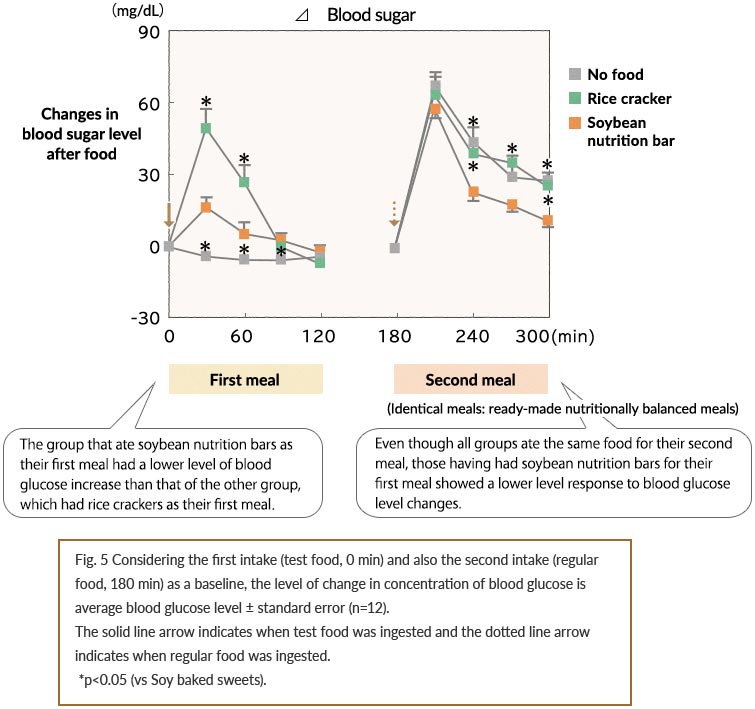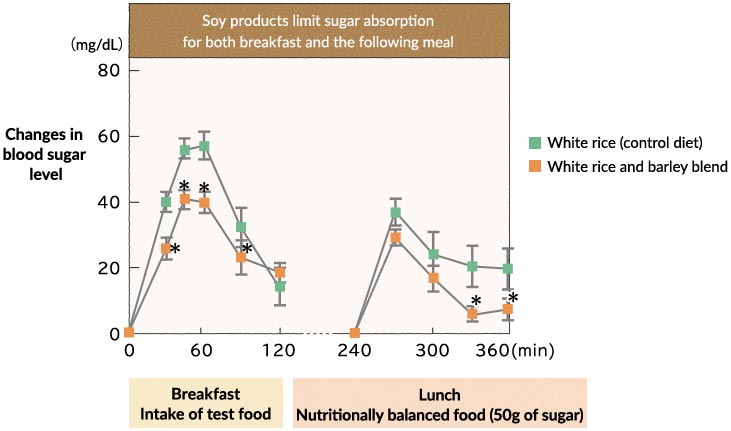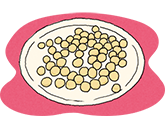What is the "Second-Meal Effect"?
The meal eaten first affects the subsequent meal's glycemic response
The second-meal effect is a concept first announced in 1982 by the developer of the low-glycemic index diet, Dr. David J. Jenkins of the University of Toronto. Dr. Jenkins defined the second-meal effect as the effect the first meal has on the blood sugar level after eating the second meal.
- Foods that contain fiber-rich legumes (soybeans, etc.) keep postprandial (after meals) blood sugar level increases to a minimum, as the viscous substances slow down the digestion and absorption.
- In addition, foods that contain fiber-rich legumes (soybeans, etc.) improve the blood sugar control of the next meal.
The following test was conducted to confirm the second-meal effect.
- At 9am the subjects ate one of the following first meals:
- 1Group 1: Soybean nutrition bar
- 2Group 2: Rice cracker
- 3Group 3: Nothing (only drank water)
- The second meal was eaten three hours later at 12pm. All subjects ate an identical meal.
- The results of the postprandial (after meal) blood sugar level are shown in the chart below.

Iwashita et al.
The Glycemic Index of Soybean Nutrition Bar and Its Second Meal Effect.
Jpn Pharmacol Ther 36(5): 417-27(2008)
The blood sugar levels of group 1, which ate the soybean nutrition bar, were far lower 240 to 300 minutes after the first meal than group 2, which ate a rice cracker. The blood sugar levels of group 1 were even lower than group 3, which had nothing to eat at the first meal. This means that eating the soybean nutrition bar as a first meal either suppressed the absorption of sugar or stimulated the secretion of hormones which drive metabolism of sugar in the blood.

Fukuhara et al.
Effect of Cooked Rice with β-glucan Enriched Barley on Postprandial Glucose Response and Its Second Meal Effect
Jpn Pharmacol Ther 41(8): 789-795(2013)
In the test, it was found that the group who ate white rice mixed with barley experienced a slower rise in blood sugar level compared to the group who just ate white rice.
In addition, it was confirmed that when white rice mixed with barley is eaten for breakfast, it also slows down the rise in blood sugar level following lunch.
When eating low GI foods, your stomach feels satisfied for longer.
As shown by this "second meal effect", soybean nutrition bars supressed the rise of blood sugar levels, for both the first meal and the second meal. In addition, the white rice mixed with barley also suppressed blood sugar level. As a result, digestion and absorption was slowed down; it is inferred that the sugars and dietary fiber which have reached the lower small intestine stimulate the secretion of hormones playing a major part in suppressing blood sugar level and sustaining the feeling of being full.
People who have a habit of snacking on high calorie and high GI foods due to feeling hungry, and who are concerned about obesity and high blood sugar levels, are recommended to choose low GI foods.






